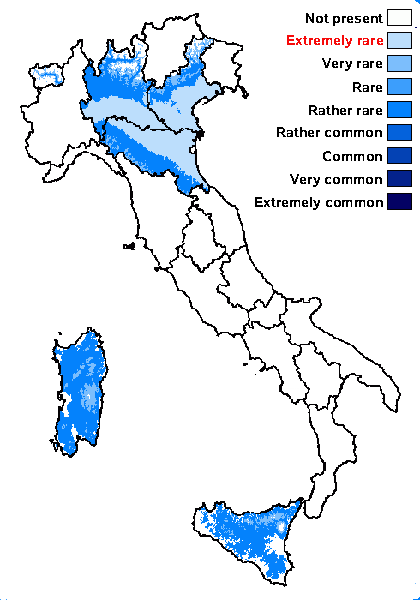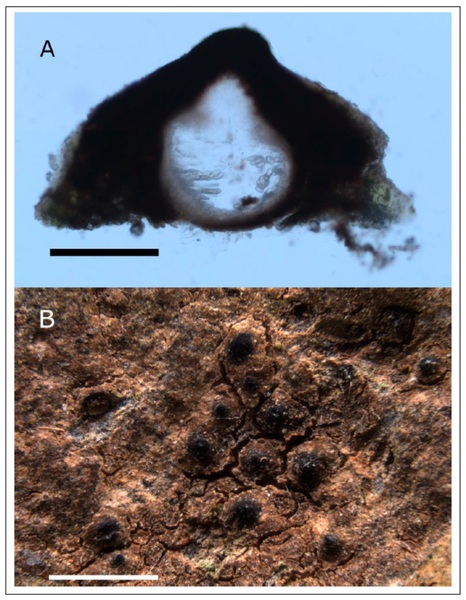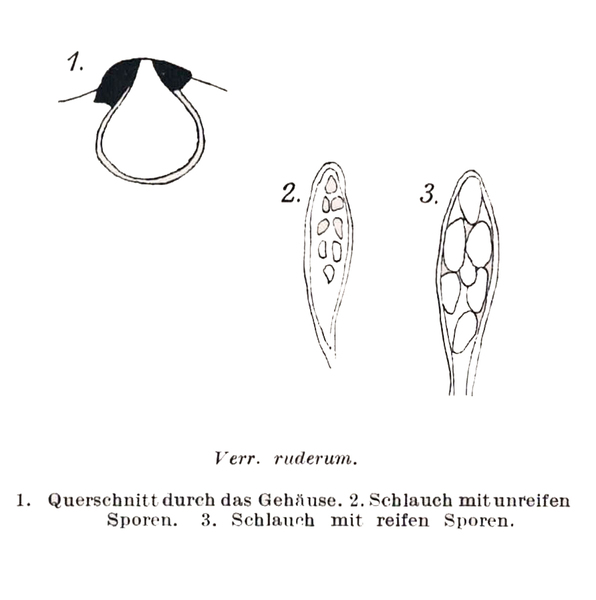Verrucaria ruderum DC.
in Lamarck & de Candolle, Fl. Franç., 3 éd., 2: 318, 1805.
Synonyms: Amphoridium ruderum (DC.) Servít
Distribution: N - Ven, Lomb, VA (Piervittori & Isocrono 1999), Emil (Nimis & al. 1996, Fariselli & al. 2020). C - Sar (Nascimbene & al. 2023). S - Si (Grillo 1998, Grillo & Caniglia 2004).
Description: Thallus crustose, thinly episubstratic, rimose-areolate, whitish to pale grey. Perithecia black, almost completely immersed in thallus, the apical part visible as an hemispherical, up to 0.2 mm wide projection. Involucrellum black, limited to the region around the ostiole, adpressed to exciple; exciple pear-shaped, up to 0.25 mm across, the wall dark brown in upper part, pale brown to colourless in lower part; hamathecium of periphyses and periphysoids, interascal filaments absent; hymenial gel hemiamyloid, I+ red (I+ blue at very low concentrations of I), K/I+ blue. Asci 8-spored, clavate, I-, fissitunicate, the wall thickened above, with an ocular chamber, dehiscent by extrusion of an endotunica to form a delicate rostrum, Verrucaria-type. Ascospores 1-celled, hyaline, ellipsoid, 23-30 x 13-18 μm. Photobiont chlorococcoid. Spot tests: K-, C-, KC-, P-, UV-. Chemistry: without lichen substances.
Note: mostly on walls made of mortar and cement. Perhaps a synonym of other species.
Growth form: Crustose
Substrata: rocks
Photobiont: green algae other than Trentepohlia
Reproductive strategy: mainly sexual
Most common in areas with a humid-warm climate (e.g. most of Tyrrenian Italy)
Poorly known taxon in need of further study
Commonnes-rarity: (info)
Alpine belt: absent
Subalpine belt: absent
Oromediterranean belt: absent
Montane belt: very rare
Submediterranean belt: rather rare
Padanian area: extremely rare
Humid submediterranean belt: rather rare
Humid mediterranean belt: absent
Dry mediterranean belt: absent

Predictive model
Growth form: Crustose
Substrata: rocks
Photobiont: green algae other than Trentepohlia
Reproductive strategy: mainly sexual
Most common in areas with a humid-warm climate (e.g. most of Tyrrenian Italy)
Poorly known taxon in need of further study
Commonnes-rarity: (info)
Alpine belt: absent
Subalpine belt: absent
Oromediterranean belt: absent
Montane belt: very rare
Submediterranean belt: rather rare
Padanian area: extremely rare
Humid submediterranean belt: rather rare
Humid mediterranean belt: absent
Dry mediterranean belt: absent

Predictive model
 Index Fungorum
Index Fungorum
 GBIF
GBIF




